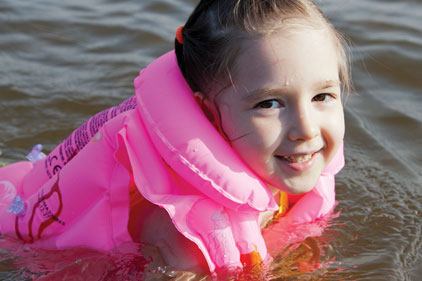Karl W. Schmidt, 60, a grandfather, was one of those drownings. He was enjoying Lake Michigan with his family over the holiday weekend when tragedy struck his 9-year-old grandson, who was pulled to shore. Schmidt was able to pass the boy to nearby surfers who took him to shore. Sadly in the confusion Schmidt had used his last ounce of energy to save the boy and went under.
Bystanders began a frantic search and found his body 200 yards from shore. His children, grandchildren, and hundreds of holiday beach goers watched in desperation as bystanders performed CPR until first responders arrived.
The same day, Tyler Buczek, 15, an 8th grade valedictorian and incoming freshman quarterback, disappeared in the waves at a Port Washington, WI, beach as his closest friends watched.
One of his friends was quoted as saying, “We're all freshmen. It’s supposed to be we're all happy, we're in high school. But I don't think that's going to be how it is this year.”
Those who know Tyler recalled a boy with a big future. He was supposed to start his first day of high school, but instead songs, prayers and tears flowed as nearly 1,000 people gathered for his beachside vigil to support the teenager's family.
Now multiply these tragic stories by 250 and counting and know that these drowning numbers will continue to rise unless a uniform water safety education program is in place.
Two men and a mission
Bob Pratt and Dave Benjamin are working without pay in an effort to save lives through their nonprofit organization, the Great Lakes Surf Rescue Project (GLSRP).
Since 2010 they have been tracking drowning statistics and, in the summers of 2011 and 2012, they performed 17 “Water Safety Surf Rescue” classes on the beaches and in the waters of Lake Michigan and Lake Superior. People who attended the classes consisted of the general public, surfers, lifeguards, Department of Natural Resource (DNR) officers, police officers, fire fighters, paramedics, water rescue team members, dive team members, and the U.S. Coast Guard.
The GLSRP intends to expand its classes to all five Great Lakes, and create a Water Safety Rip Current Survival national curriculum, in order to reduce these drownings.
Pratt recently retired after 25 years of service as paramedic, fire fighter, and fire marshal for the city of East Lansing, MI, to take the helm of the GLSRP full-time. He is also a certified lifeguard, CPR, and first aid instructor and has served as the lead trainer for the fire department’s water and ice rescue training as well as several police and fire agencies in Michigan, including Lansing Community College’s Police Academy.
Pratt became an advocate for Great Lakes water safety when he was going to teach his son to surf September 3, 2003. On that day at the beach, U.S. Coast Guard helicopters and boats were in the water searching for Andy Fox, who got caught in a rip current at Grand Haven State Park.
“We spent some time on the beach just reflecting and were deeply affected by the event,” said Pratt. “I was appalled to learn how common drownings were on the Great Lakes. Very few beaches have lifeguards, and bystanders are often the only hope a drowning victim has.”
Fox’s death sparked Pratt’s interest in rip currents and he later worked with Fox’s mom on several projects including the “Great Lakes Beach and Pier Safety Task Force” and the “Beach Safety Challenge”.
Dave Benjamin has swum in Lake Michigan for 42 years and started surfing the Lake in 2009. While surfing in 2010 he survived a nonfatal drowning accident which prompted his dedication to this cause.
“After swimming in the lake my whole life, I was pretty comfortable in the water,” said Benjamin, executive director of the GLSRP. “But all it took was one moment of panic for all experience and rational thought to go out the window.”
According to Benjamin, when he was drowning, he remembered an article titled, “Drowning doesn’t look like drowning” by Mario Vittone and it saved his life.
“I was doing all the signs [of drowning] and when I stopped doing the signs, I was able to eventually float to safety.”
This summer Benjamin participated in an unsuccessful water rescue and witnessed several bodies pulled from the water.
“Going to the beach is supposed to be about family fun, recreation, love and happiness. Not about tragedy, despair, and hopelessness,” Benjamin concluded.
The solution
The GLSRP is working with the Michigan Sea Grant’s “Flip, Float, and Follow” rip current survival strategy, to develop a national curriculum similar to the Fire Prevention Services’ “Stop, Drop and Roll” program.
“Ask anyone anywhere in the United States and they probably know ‘Stop, Drop and Roll,’” Benjamin aptly noted, hoping “Flip, Float, Follow” can catch on as well.”
The GLSRP has been promoting the Michigan Sea Grant’s “Flip, Float, and Follow” rip current survival strategy through its “Water Safety Surf Rescue” classes this summer and it has received over 30 media mentions.
With some funding, the GLSRP is ready to launch a regional and then national water safety curriculum to teach the public how to:
- Use the Michigan Sea Grants “Flip, Float, and Follow” rip current survival strategy
- Recognize the dangers and hazards of the Great Lakes surf environment keeping personal safety as the primary responsibility
- Implement Hands-on Adult Supervision
- Designate Water Watchers (The Water Watcher Card)
- Recognize the “Signs of Drowning” – How to identify a person in trouble from within a crowd (The Hollywood version of drowning is alarmingly inaccurate)
- Understand rip currents; i.e. how, where, and why rip currents occur
- Know the dangerous currents
- Know the dangers of offshore winds
- Use a flotation device or surfboard to rescue a person in distress or in a rip current
- React when encountering swimmers who have suffered an injury or are unconscious
- Enroll in lifesaving, first aid and CPR training from accredited agencies.
Price of apathy
If no uniform public water safety curriculum is undertaken, the Great Lakes drowning epidemic will definitely continue to rise, especially as the beaches continue to receive national recognition and multimillion dollar restoration projects. More attractive beaches result in more bathers and, without effective intervention, more drownings.
Although the GLSRP is a young organization, it has made some huge accomplishments in less than two years and is ready to handle the challenge of delivering this national water safety curriculum.





